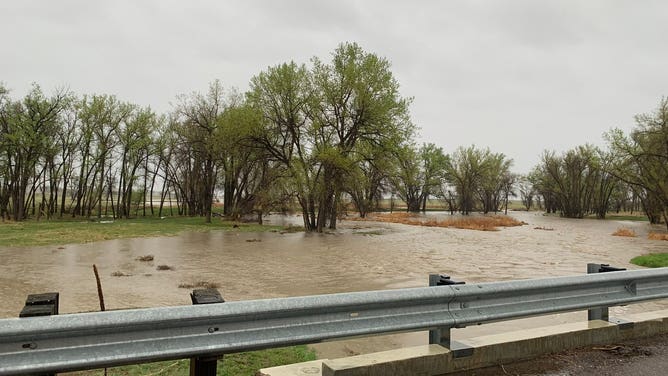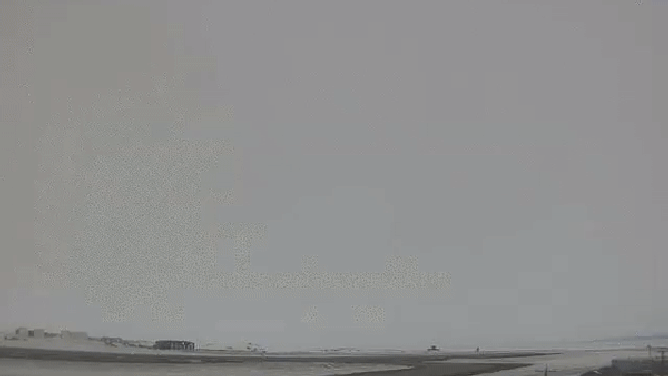Weekend Weather Wows: Denver gets so much rain while Minnesota gets a worm warning?
Welcome to our weekly feature where we'll go back and find the most exciting tidbits of weather you might have missed over the past week, so you'll be ready to impress at the water cooler (or virtual water cooler) come Monday.

High waters along First Creek in Colorado amid heavy rains.
(Rocky Mountain Arsenal NWR / FOX Weather)
Why wait a pesky three months to collect your average rainfall when you can get it all within three days?
Welcome to our weekly feature, "Weekend Weather Wows," where we'll go back and find the most exciting tidbits of weather you might have missed over the past week, so you'll be ready to impress at the water cooler (or virtual water cooler) come Monday.
Denver gets a ridiculous amount of rain
Denver makes weather headlines for snow, or sometimes those wacky temperature drops where it's 80 degrees at breakfast and 20 degrees and snowing by lunch. Sometimes, it's tornadoes trying to mess with the airport or hail bashing in car windows. But rain? The city only averages about 14.5 inches of precipitation a year.

(FOX Weather)
So it is quite strange when the Mile High City collects over 4 inches of rain in three days.
The 2.92 inches that fell Thursday was the city's eighth-wettest day, and records go back 152 years. Through Friday, the 4.45-inch three-day total was nearly a third (31%) of their annual rainfall.
If that's tough for Denverites to put into the proper perspective, the National Weather Service office in Boulder helpfully translated the storm into a more familiar unit of measurement:
Don't worry about all this rainy news. I'm sure the city will soon get back to getting snow on a day it also hit 100 degrees some other time this spring, or fall, or Tuesday.
A particularly wiggly situation?
It wasn't rain or snow or hail in Minnesota that got forecasters' attention.
It was worms.
"WORM WARNING!" the NWS office in Minneapolis joked on Thursday. "Areas along and south of I-94 can expect to see, smell, and step on many worms this morning. Proceed with caution."
I've never lived in Minnesota (and honestly, this tweet doesn't exactly scream "come to MSP!") But it sounds like the worms came out with the recent rains there.
Gross. I'll stick with my… slimy slugs when it rains up here in the Northwest?

(Photo by Rudolf-Peter Bakker on Unsplash / FOX Weather)
Hail so cold it can be seen from space
Speaking of hail, check out the icy scene from above Nebraska this week - no, not from a helicopter or drone, but from outer space.
Infrared satellite was able to pick up a hailstorm that moved through the Hastings area.
The black blob is the storm; the blue trail left behind like candies to mark a return path on a hike – that is the infrared satellite picking up the cold signature of accumulated hail left on the ground.
Lightning can be seen from space too
It was an electric scene in Idaho on Tuesday, not only with lightning easily seen from any helicopters or drones, but from outer space.
The GOES-West weather satellite picked up numerous thunderstorms spinning around the Inland Northwest.
Thunderstorms aren't rare but not exactly common in the Northwest – even for the inland areas. Idaho ranks 38th in the U.S. in number of recorded lightning strikes a year, according to Vaisala XWeather.
The National Weather Service in Boise said the 86 lightning strikes recorded in the Treasure Valley rated among their top 5% of lightning events in May, with 828 strikes recorded across southern Idaho and eastern Oregon.
LIGHTNING SAFETY: WHEN THUNDER ROARS, EVEN TAKING OUT THE TRASH CAN TURN DEADLY
Hey! What happened to my pretty sunsets?
It's now that time in parts of Alaska when the phrase "as sure as the sun will rise tomorrow" gets an asterisk.
Thursday marked the date when those above the Arctic Circle ditch any semblance of real darkness. The sun rose in Utqiagvik (formerly Barrow) on Alaska northern shores Thursday morning just after 2 a.m., and it's the last time the sun will dip below the horizon until Aug. 2. Whether it's 2 a.m. or 2 p.m, there's sun.

It may not look like it because of the clouds and fog, but Utqiagvik, Alaska, has begun their 83-day sunset-less streak, the National Weather Service says.
(NWS Fairbanks / FOX Weather)
Then after the sun finally sets (for 54 minutes) on Aug. 2, the race will be on toward the opposite 24-hour darkness come the winter. In between, the town will lose as much as 10-15 minutes of daylight a day. That's roughly an hour a week.
Not that the nearly all-day sun has helped much
Anchorage, which does get to enjoy at least some brief darkness sitting below the Arctic Circle, still hasn't been able to take much advantage.
The city didn't reach its first 50-degree reading until May 7, tying it with 1973 and 1964 for the third-longest wait for an inaugural 50-degree day.
Other weather tidbits this week:
- Osborne, Kansas, had a peak wind gust of 81 mph on Tuesday from severe thunderstorms.
- Heavy rains brought 5.29 inches to New Orleans City Park on Tuesday.
- The 2.25 inches in Greenville County, South Carolina, on Tuesday, ranks as one of largest measured there since 1950.
Need more weather? Check your local forecast plus 3D radar in the FOX Weather app. You can also watch FOX Weather wherever you go using the FOX Weather app at foxweather.com/live or on your favorite streaming service.
You can share your weather pictures and videos with us anytime, anywhere, in our America's Weather Watchers community on Facebook, email them to weather@fox.com or add the hashtag #FOXWeather to your post on your favorite social media platform.